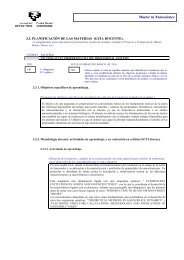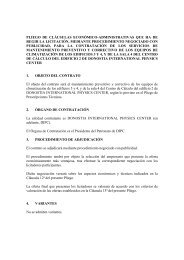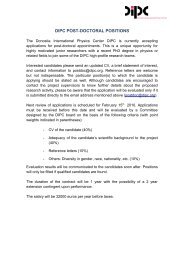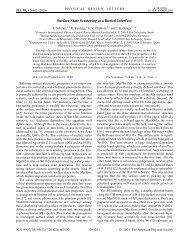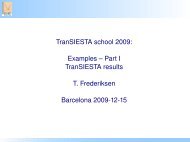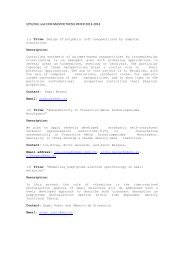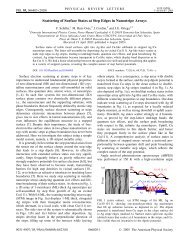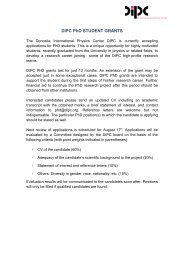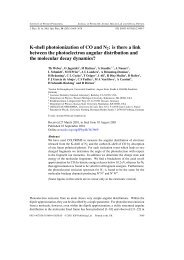First-principles calculation of the electron inelastic mean free path in ...
First-principles calculation of the electron inelastic mean free path in ...
First-principles calculation of the electron inelastic mean free path in ...
You also want an ePaper? Increase the reach of your titles
YUMPU automatically turns print PDFs into web optimized ePapers that Google loves.
PHYSICAL REVIEW B 68, 205106 2003<br />
<strong>First</strong>-<strong>pr<strong>in</strong>ciples</strong> <strong>calculation</strong> <strong>of</strong> <strong>the</strong> <strong>electron</strong> <strong><strong>in</strong>elastic</strong> <strong>mean</strong> <strong>free</strong> <strong>path</strong> <strong>in</strong> Be metal<br />
V. M. Silk<strong>in</strong>, 1 E. V. Chulkov, 1,2 and P. M. Echenique 1,2<br />
1 Donostia International Physics Center (DIPC) and Centro Mixto CSIC-UPV/EHU, Paseo de Manuel Lardizabal, 4,<br />
20018 San Sebastián/Donostia, Basque Country, Spa<strong>in</strong><br />
2 Departamento de Física de Materiales, Facultad de Ciencias Químicas, UPV/EHU, Apdo. 1072, 20080 San Sebastián/Donostia,<br />
Basque Country, Spa<strong>in</strong><br />
Received 14 July 2003; published 21 November 2003<br />
The Be <strong>electron</strong> <strong><strong>in</strong>elastic</strong> <strong>mean</strong> <strong>free</strong> <strong>path</strong> IMFP is calculated by us<strong>in</strong>g <strong>the</strong> GW approximation <strong>of</strong> many-body<br />
<strong>the</strong>ory. It is demonstrated that <strong>the</strong> <strong>in</strong>clusion <strong>of</strong> band structure effects significantly improves <strong>the</strong> agreement<br />
between <strong>the</strong> calculated and measured IMFP <strong>in</strong> <strong>the</strong> energy range up to 30 eV. We show that <strong>the</strong> ma<strong>in</strong> effect<br />
results from <strong>the</strong> <strong>electron</strong> group velocity obta<strong>in</strong>ed from ab <strong>in</strong>itio band structure <strong>calculation</strong>s, whereas <strong>the</strong><br />
evaluated l<strong>in</strong>ewidth averaged over momenta is not significantly affected with respect to <strong>the</strong> prediction <strong>of</strong> a <strong>free</strong><br />
<strong>electron</strong> gas model. The comparison <strong>of</strong> <strong>the</strong> IMFP computed with<strong>in</strong> two models, namely, <strong>the</strong> <strong>free</strong> <strong>electron</strong> gas<br />
model and <strong>the</strong> full band structure model, supports <strong>the</strong> idea <strong>of</strong> <strong>the</strong> importance <strong>of</strong> band structure effects for <strong>the</strong><br />
description <strong>of</strong> <strong>electron</strong> transport <strong>in</strong> this metal for energies below 30 eV, and a nearly <strong>free</strong>-<strong>electron</strong>-like behavior<br />
for excitation energies above 30 eV. The calculated plasmon dispersion is <strong>in</strong> excellent agreement with available<br />
experimental data.<br />
DOI: 10.1103/PhysRevB.68.205106<br />
PACS numbers: 71.20.Dg, 71.45.Gm, 72.15.Lh<br />
I. INTRODUCTION<br />
The <strong>electron</strong> <strong><strong>in</strong>elastic</strong> <strong>mean</strong> <strong>free</strong> <strong>path</strong> IMFP is <strong>of</strong> great<br />
importance for an analysis <strong>of</strong> data <strong>of</strong> various spectroscopies<br />
such as energy loss spectroscopy, low energy <strong>electron</strong> diffraction,<br />
photoemission spectroscopy, two-photon photoemission,<br />
and time-resolved two-photon photoemission, and<br />
a lot <strong>of</strong> experimental and <strong>the</strong>oretical work on this subject has<br />
been done dur<strong>in</strong>g <strong>the</strong> last several decades see, for <strong>in</strong>stance,<br />
Refs. 1 and 2. The <strong><strong>in</strong>elastic</strong> <strong>mean</strong> <strong>free</strong> <strong>path</strong> <strong>of</strong> <strong>the</strong> <strong>electron</strong><br />
quasiparticle is def<strong>in</strong>ed as a distance that an excited <strong>electron</strong><br />
covers <strong>in</strong> <strong>the</strong> lifetime which sets <strong>the</strong> duration <strong>of</strong> <strong>the</strong> excitation,<br />
i.e., <strong>the</strong> IMFP is <strong>the</strong> product <strong>of</strong> <strong>the</strong> <strong><strong>in</strong>elastic</strong> lifetime<br />
and <strong>the</strong> group velocity v. <strong>First</strong> <strong>calculation</strong>s <strong>of</strong> and <br />
were performed by Qu<strong>in</strong>n and Ferrell 3 <strong>in</strong> a degenerate <strong>electron</strong><br />
gas model with<strong>in</strong> <strong>the</strong> self-energy formalism <strong>of</strong> manybody<br />
<strong>the</strong>ory. Later <strong>the</strong>se evaluations were extended to <strong>in</strong>clude,<br />
with<strong>in</strong> <strong>the</strong> first-Born and random-phase<br />
approximations, energies far away from <strong>the</strong> Fermi surface. 4,5<br />
S<strong>in</strong>ce <strong>the</strong>n, many <strong>calculation</strong>s <strong>of</strong> <strong>the</strong> IMFP and <strong>electron</strong><strong>electron</strong><br />
scatter<strong>in</strong>g rates <strong>in</strong>verse lifetimes have been performed<br />
with <strong>the</strong> <strong>in</strong>clusion <strong>of</strong> exchange and correlation<br />
effects, 6–9 chemical potential renormalization, 10,11 plasmon<br />
damp<strong>in</strong>g, 12 and core polarizability. 13 Statistical approximations<br />
were also used <strong>in</strong> <strong>the</strong> evaluations <strong>of</strong> <strong>the</strong> IMFP. 14,15 Band<br />
structure effects, <strong>in</strong>clud<strong>in</strong>g sp<strong>in</strong> dependence <strong>of</strong> <strong>the</strong> IMFP,<br />
were discussed <strong>in</strong> Refs. 16–20. Very recently more sophisticated<br />
methods, namely, first-<strong>pr<strong>in</strong>ciples</strong> band structure methods,<br />
have been used to perform ab <strong>in</strong>itio <strong>calculation</strong>s <strong>of</strong> <strong>the</strong><br />
<strong>in</strong>verse lifetime l<strong>in</strong>ewidth for low energy hot <strong>electron</strong>s and<br />
holes <strong>in</strong> metals 21–27 and <strong>in</strong> a large energy <strong>in</strong>terval for<br />
silicon. 28 The ab <strong>in</strong>itio GW evaluations <strong>of</strong> <strong>the</strong> IMFP at high<br />
energies have also been performed for beryllium<br />
chalcogenides. 29 As a result <strong>of</strong> <strong>the</strong>se <strong>in</strong>tensive studies it is<br />
believed now that <strong>the</strong> behavior <strong>of</strong> <strong>the</strong> IMFP for high energies<br />
higher than several tens <strong>of</strong> <strong>electron</strong>volts is well understood<br />
and well described <strong>in</strong> <strong>the</strong> framework <strong>of</strong> exist<strong>in</strong>g <strong>the</strong>ories. 1,2<br />
For example, a <strong>the</strong>oretical prediction is that for high energies<br />
<strong>the</strong> IMFP <strong>in</strong> <strong>free</strong>-<strong>electron</strong>-like metals is a function <strong>of</strong> <strong>the</strong><br />
valence <strong>electron</strong> density only and has a similar behavior.<br />
However, <strong>the</strong>re are <strong>in</strong>dications that even for energies above<br />
30 eV <strong>the</strong> band structure <strong>of</strong> some materials is far from<br />
nearly-<strong>free</strong>-<strong>electron</strong>-like. 30 At low energies <strong>the</strong> IMFP is very<br />
sensitive to details <strong>of</strong> <strong>the</strong> band structure. 21–26 In particular,<br />
<strong>the</strong> deviations <strong>of</strong> <strong>the</strong> IMFP from <strong>the</strong> <strong>free</strong>-<strong>electron</strong>-like prediction<br />
at energies around 10 eV found for K and Rb Ref.<br />
31 were attributed to unoccupied d bands which are situated<br />
at <strong>the</strong>se energies. 27,31 But even more pr<strong>of</strong>ound discrepancies<br />
between <strong>the</strong> experimental and <strong>the</strong>oretical IMFPs were found<br />
for beryllium. 32 Photoemission measurements <strong>of</strong> Johansson<br />
and Sernelius 32 showed that <strong>the</strong> experimental IMFP, , has a<br />
m<strong>in</strong>imum for energies close to 25 eV, go<strong>in</strong>g down to 1.8 Å.<br />
The <strong>calculation</strong>s performed with<strong>in</strong> <strong>the</strong> degenerate <strong>free</strong> <strong>electron</strong><br />
gas FEG model do not reproduce this m<strong>in</strong>imum.<br />
Moreover <strong>the</strong>se evaluations place <strong>the</strong> <strong>the</strong>oretical (E) curve<br />
higher than <strong>the</strong> experimental one by a factor <strong>of</strong> 3–4 for<br />
excitation energies below 30 eV. 32 The authors <strong>of</strong> Ref. 32<br />
proposed several possible explanations <strong>of</strong> <strong>the</strong> observed discrepancies<br />
between <strong>the</strong>ir experimental results and <strong>the</strong> FEG<br />
<strong>the</strong>ory, <strong>in</strong> particular <strong>the</strong> follow<strong>in</strong>g.<br />
1 Flat or negative dispersion <strong>of</strong> a bulk plasmon <strong>in</strong> a real<br />
crystal can significantly reduce <strong>the</strong> measured IMFP.<br />
2 The experimental IMFP may be reduced by excitation<br />
<strong>of</strong> surface plasmon.<br />
3 The reduction <strong>of</strong> <strong>the</strong> IMFP is produced by excitation<br />
<strong>of</strong> surface states, which play important role <strong>in</strong> <strong>the</strong> surfaces <strong>of</strong><br />
Be. 33–36<br />
The two last explanations were motivated by <strong>the</strong> use <strong>of</strong><br />
<strong>the</strong> measurement method: <strong>the</strong> authors <strong>of</strong> Ref. 32 derived <strong>the</strong><br />
<strong><strong>in</strong>elastic</strong> <strong>mean</strong> <strong>free</strong> <strong>path</strong> from <strong>the</strong> measured core level shifts<br />
<strong>of</strong> Be atoms <strong>in</strong> two surface layers <strong>of</strong> Be0001 and Be(101¯0)<br />
by us<strong>in</strong>g <strong>the</strong> layer attenuation model. 31 These core level<br />
shifts can be affected, <strong>in</strong> pr<strong>in</strong>ciple, by a surface collective<br />
excitation surface plasmon as well as by a s<strong>in</strong>gle-particle<br />
0163-1829/2003/6820/2051066/$20.00<br />
68 205106-1<br />
©2003 The American Physical Society
V. M. SILKIN, E. V. CHULKOV, AND P. M. ECHENIQUE PHYSICAL REVIEW B 68, 205106 2003<br />
excitation from <strong>the</strong> ¯ surface state band on Be0001 Refs.<br />
33 and 34 or from <strong>the</strong> Ā surface state on Be(101¯0). 35 In <strong>the</strong><br />
present work we show that, <strong>in</strong> fact, most <strong>of</strong> <strong>the</strong> discrepancies<br />
between <strong>the</strong> experiment and <strong>the</strong> <strong>calculation</strong> based on <strong>the</strong><br />
FEG model, 32 may be removed by tak<strong>in</strong>g explicitly <strong>in</strong>to account<br />
<strong>the</strong> Be bulk band structure. We <strong>in</strong>vestigate <strong>the</strong> plasmon<br />
dispersion <strong>in</strong> bulk Be and demonstrate that although it deviates<br />
from <strong>the</strong> prediction <strong>of</strong> <strong>the</strong> FEG model, it does not <strong>in</strong>fluence<br />
significantly <strong>the</strong> IMFP <strong>in</strong> beryllium derived from <strong>the</strong><br />
FEG model. We demonstrate that <strong>the</strong> ma<strong>in</strong> effect <strong>of</strong> <strong>the</strong> band<br />
structure on <strong>the</strong> IMFP comes from <strong>the</strong> fact that <strong>the</strong> group<br />
velocity <strong>in</strong> beryllium is significantly lower than that evaluated<br />
with<strong>in</strong> <strong>the</strong> FEG model, thus lead<strong>in</strong>g to much better<br />
agreement with <strong>the</strong> experiment. On base <strong>of</strong> <strong>the</strong> performed<br />
<strong>calculation</strong>s <strong>of</strong> both <strong>the</strong> <strong>electron</strong> lifetime and <strong>the</strong> group velocity<br />
we analize relative importance <strong>of</strong> band structure effects<br />
on IMFP <strong>in</strong> Be for two energy regions, namely, below<br />
and above 30 eV.<br />
The paper is organized as follows. In Sec. II we give <strong>the</strong><br />
brief description <strong>of</strong> <strong>the</strong> self-energy approach <strong>of</strong> many-body<br />
<strong>the</strong>ory for <strong>the</strong> evaluation <strong>of</strong> <strong>the</strong> <strong>in</strong>verse lifetime <strong><strong>in</strong>elastic</strong><br />
l<strong>in</strong>ewidth <strong>of</strong> an excited <strong>electron</strong>. The <strong>calculation</strong> results are<br />
presented and discussed <strong>in</strong> Sec. III and <strong>the</strong> conclusions are<br />
given <strong>in</strong> Sec. IV. Unless o<strong>the</strong>rwise stated, atomic units are<br />
used throughout, i.e., e 2 m e 1.<br />
II. CALCULATION METHOD<br />
Band structure <strong>calculation</strong>s yield one-<strong>electron</strong> states,<br />
which are characterized by energies nk and wave functions<br />
nk (r), where n and k are <strong>the</strong> band number and momentum,<br />
respectively. To all <strong>the</strong>se one-<strong>electron</strong> states one can attribute<br />
a group velocity nk def<strong>in</strong>ed as 37<br />
nk nk /k<br />
1<br />
and <strong>the</strong> lifetime nk . By us<strong>in</strong>g <strong>the</strong> Heisenberg relation<br />
nk nk 1 <strong>the</strong> l<strong>in</strong>ewidth nk <strong>of</strong> a given <strong>electron</strong>ic state is<br />
determ<strong>in</strong>ed as <strong>the</strong> <strong>in</strong>verse lifetime 1 nk . Know<strong>in</strong>g nk and<br />
nk , we calculate <strong>the</strong> <strong><strong>in</strong>elastic</strong> <strong>electron</strong> <strong>mean</strong> <strong>free</strong> <strong>path</strong> nk<br />
<strong>of</strong> a given state as<br />
nk nk / nk .<br />
In <strong>the</strong> FEG model, where a simple relation between <strong>the</strong><br />
momentum k and <strong>the</strong> one-<strong>electron</strong> energy nk k 2 /2m exists,<br />
<strong>the</strong> group velocity nk and l<strong>in</strong>ewidth nk are functions <strong>of</strong> an<br />
absolute value <strong>of</strong> momentum; i.e., <strong>the</strong>y depend only on a<br />
quasiparticle energy, while band structure based <strong>the</strong>ories give<br />
<strong>the</strong> velocity and <strong>the</strong> <strong>electron</strong> l<strong>in</strong>ewidth as functions <strong>of</strong> both<br />
<strong>the</strong> energy and momentum. For a comparison with experimental<br />
results, one should evaluate resolved <strong>in</strong> energy<br />
only. The <strong>electron</strong> IMFP <strong>in</strong> bulk Be was obta<strong>in</strong>ed <strong>in</strong> Ref. 32<br />
from measurements <strong>of</strong> core-level shifts <strong>in</strong> <strong>the</strong> first two<br />
atomic layers. In such types <strong>of</strong> experiment, after an excitation<br />
from <strong>the</strong> core-level shells, which form bands with a zero<br />
dispersion, excited <strong>electron</strong>s with <strong>the</strong> same energy have similar<br />
probabilities, <strong>in</strong> pr<strong>in</strong>ciple, to occupy all one-<strong>electron</strong><br />
states characterized by different momenta k. Therefore, <strong>in</strong><br />
2<br />
FIG. 1. The calculated unoccupied <strong>electron</strong>ic structure <strong>of</strong> Be<br />
along symmetry directions <strong>of</strong> <strong>the</strong> BZ. The zero energy value corresponds<br />
to <strong>the</strong> Fermi level.<br />
<strong>the</strong> present work we assume an equal probability for population<br />
<strong>of</strong> one-<strong>electron</strong> states with different k for <strong>the</strong> same<br />
energy . With this assumption we evaluate values <strong>of</strong> <strong>the</strong><br />
IMFP, nk as a modulus <strong>of</strong> vector quantity, nk nk .<br />
Then, for comparison with experiment, we determ<strong>in</strong>e IMFP<br />
() as an average <strong>of</strong> nk over all wave vectors and energy<br />
bands with <strong>the</strong> same excitation energy <strong>in</strong> <strong>the</strong> irreducible part<br />
<strong>of</strong> <strong>the</strong> Brillou<strong>in</strong> zone IBZ. After this procedure one obta<strong>in</strong>s<br />
<strong>the</strong> value <strong>of</strong> <strong>the</strong> <strong>mean</strong> <strong>free</strong> <strong>path</strong> () as a function <strong>of</strong> <strong>electron</strong><br />
energy only.<br />
For <strong>the</strong> evaluation <strong>of</strong> wave functions nk (r) and one<strong>electron</strong><br />
energies nk we employ a self-consistent pseudopotential<br />
method with <strong>the</strong> local-density approximation<br />
LDA for <strong>the</strong> exchange-correlation potential. 38 To describe<br />
<strong>the</strong> Be <strong>electron</strong>-ion <strong>in</strong>teraction, a norm-conserv<strong>in</strong>g pseudopotential<br />
39 has been used. The <strong>calculation</strong>s have been performed<br />
for a hcp crystal structure with experimental lattice<br />
parameters a2.2850 Å and c3.5847 Å. 40 In <strong>the</strong> wave<br />
function expansion <strong>the</strong> plane waves up to E cut 24 Ry have<br />
been <strong>in</strong>cluded. The correspond<strong>in</strong>g unoccupied band structure<br />
along high symmetry directions <strong>of</strong> <strong>the</strong> Brillou<strong>in</strong> zone is<br />
shown <strong>in</strong> Fig. 1.<br />
The l<strong>in</strong>ewidth nk <strong>of</strong> <strong>the</strong> <strong>electron</strong> state is related to <strong>the</strong><br />
imag<strong>in</strong>ary part <strong>of</strong> <strong>the</strong> <strong>electron</strong> self-energy nk : 41<br />
nk 2Im nk ,<br />
where Im nk is evaluated as a projection <strong>of</strong> Im (r,r; nk )<br />
onto <strong>the</strong> one-<strong>electron</strong> state nk (r), 42,43<br />
3<br />
Im nk nk<br />
* rIm r,r; nk nk rdrdr. 4<br />
The self-energy (r,r; nk ) is calculated with<strong>in</strong> <strong>the</strong> GW approximation<br />
<strong>of</strong> many-body <strong>the</strong>ory, 42 with W be<strong>in</strong>g <strong>the</strong> dynamically<br />
screened Coulomb <strong>in</strong>teraction, and <strong>the</strong> Green<br />
function G replaced by <strong>the</strong> non<strong>in</strong>teract<strong>in</strong>g Green function.<br />
Thus, for Im , one obta<strong>in</strong>s<br />
205106-2
FIRST-PRINCIPLES CALCULATION OF THE ...<br />
PHYSICAL REVIEW B 68, 205106 2003<br />
Im r,r; nk <br />
F mq nk<br />
mq<br />
* rIm Wr,r;E nk,mq mq r, 5<br />
m,q<br />
where <strong>the</strong> sum is extended over <strong>the</strong> f<strong>in</strong>al states mq (r) with<br />
energy mq , F is <strong>the</strong> Fermi energy, and E nk,mq nk<br />
mq . The screened Coulomb <strong>in</strong>teraction W(r,r,) is<br />
Wr,r; 1 r,r;Vrrdr. 6<br />
Here, 1 (r,r,) and V(r) represent <strong>the</strong> <strong>in</strong>verse dielectric<br />
function and <strong>the</strong> bare Coulomb potential, respectively.<br />
With<strong>in</strong> <strong>the</strong> random phase approximation RPA <strong>the</strong> Fourier<br />
transform <strong>of</strong> <strong>the</strong> dielectric matrix GG (k,), where G and<br />
G are reciprocal lattice vectors, is related to <strong>the</strong> densitydensity<br />
response function GG<br />
0<br />
(k,) for a non<strong>in</strong>teract<strong>in</strong>g<br />
<strong>electron</strong> system,<br />
0<br />
GG k, GG GG<br />
k,V G k, 7<br />
where V G (k) is <strong>the</strong> Fourier transform <strong>of</strong> <strong>the</strong> bare Coulomb<br />
potential:<br />
and<br />
0<br />
GG<br />
k, 2 BZ<br />
q<br />
V G k<br />
4<br />
kG 2<br />
<br />
n,n<br />
f nq f n kq<br />
nq n kqi<br />
nq e i(kG)•r n kq<br />
n kqe i(kG)•r nq . 9<br />
In Eq. 9 <strong>the</strong> sums run over <strong>the</strong> q vectors <strong>in</strong> <strong>the</strong> first Brillou<strong>in</strong><br />
zone and over all bands n and n. f nq is <strong>the</strong> Fermi<br />
distribution function, a positive <strong>in</strong>f<strong>in</strong>itesimal, and <strong>the</strong><br />
crystal volume.<br />
As it has been shown by Maddocks et al., 44 <strong>the</strong> RPA is a<br />
good approximation for <strong>calculation</strong> <strong>of</strong> 1 GG<br />
(q,) for Be,<br />
that is a key quantity for evaluation <strong>of</strong> nk . Therefore, <strong>in</strong> <strong>the</strong><br />
present work we perform <strong>calculation</strong>s with<strong>in</strong> <strong>the</strong> RPA.<br />
To evaluate <strong>the</strong> density-density response function 0 , a<br />
method <strong>of</strong> analytical cont<strong>in</strong>uation similar to that used <strong>in</strong> Ref.<br />
44 has been employed. A sampl<strong>in</strong>g over <strong>the</strong> BZ was performed<br />
on <strong>the</strong> mesh <strong>of</strong> 6912 q po<strong>in</strong>ts. For <strong>electron</strong> excitation<br />
energies under study below 50 eV, <strong>the</strong> <strong>in</strong>clusion <strong>of</strong> up to 50<br />
energy bands <strong>in</strong> Eq. 9 has been required.<br />
Us<strong>in</strong>g Fourier transforms for all quantities <strong>in</strong> Eqs. 4 and<br />
5 we obta<strong>in</strong><br />
nk 2<br />
F mq nk<br />
<br />
mq<br />
Im W GG kq, nk mq <br />
G,G<br />
B nm<br />
* k,q;GB nm k,q;G, 10<br />
where W GG is <strong>the</strong> Fourier transform <strong>of</strong> <strong>the</strong> screened Coulomb<br />
<strong>in</strong>teraction W(r,r;) and B nm (k,q;G) are<br />
8<br />
FIG. 2. The IMFP dependence on <strong>the</strong> <strong>electron</strong> energy. The solid<br />
l<strong>in</strong>e shows <strong>the</strong> calculated ab <strong>in</strong>itio IMFP, and <strong>the</strong> dashed l<strong>in</strong>e corresponds<br />
to <strong>the</strong> IMFP calculated with<strong>in</strong> <strong>the</strong> FEG model. The dotted<br />
l<strong>in</strong>e represents <strong>the</strong> IMFP with <strong>the</strong> l<strong>in</strong>ewidth obta<strong>in</strong>ed from <strong>the</strong> FEG<br />
model and <strong>the</strong> group velocity from real band structure <strong>of</strong> Be. The<br />
dash-dotted l<strong>in</strong>e describes <strong>the</strong> IMFP with <strong>the</strong> l<strong>in</strong>ewidth derived<br />
from first <strong>pr<strong>in</strong>ciples</strong> and <strong>the</strong> group velocity taken from <strong>the</strong> FEG<br />
model. Filled circles and squares are <strong>the</strong> experimental values obta<strong>in</strong>ed<br />
for <strong>the</strong> 0001 and (101¯0) Be surfaces, respectively.<br />
B nm k,q;G a n<br />
*kGG•a m qG, 11<br />
G<br />
and a n (kG) are <strong>the</strong> wave function expansion coefficients.<br />
In Eq. 10 summ<strong>in</strong>g has been performed over 765 q po<strong>in</strong>ts<br />
<strong>in</strong> <strong>the</strong> IBZ. To estimate <strong>the</strong> accuracy which is achieved with<br />
this number <strong>of</strong> q po<strong>in</strong>ts we have also performed <strong>calculation</strong>s<br />
with 425 q po<strong>in</strong>ts <strong>in</strong> <strong>the</strong> IBZ. The results <strong>of</strong> both <strong>the</strong> <strong>calculation</strong>s<br />
<strong>of</strong> nk agree with<strong>in</strong> 1%. On <strong>the</strong> o<strong>the</strong>r hand, nk is<br />
more sensitive to <strong>the</strong> number <strong>of</strong> <strong>the</strong> reciprocal lattice vectors<br />
G used <strong>in</strong> Eq. 10, and f<strong>in</strong>al results have been obta<strong>in</strong>ed with<br />
<strong>the</strong> use <strong>of</strong> 40 G vectors. This number ensures a convergence<br />
<strong>of</strong> nk for k po<strong>in</strong>ts near <strong>the</strong> center <strong>of</strong> <strong>the</strong> BZ with<strong>in</strong> a few<br />
percent. At <strong>the</strong> same time, for k near <strong>the</strong> borders <strong>of</strong> <strong>the</strong> BZ<br />
<strong>the</strong> accuracy is 5%. Tak<strong>in</strong>g <strong>in</strong>to account every step <strong>of</strong> our<br />
<strong>calculation</strong>s, we estimate <strong>the</strong> overall accuracy <strong>of</strong> <strong>the</strong> evaluated<br />
values <strong>of</strong> nk around 10% <strong>of</strong> course, any estimations<br />
related to <strong>the</strong> different level <strong>of</strong> consideration beyond <strong>the</strong> GW<br />
approximation are not <strong>in</strong>cluded <strong>in</strong> this analysis.<br />
III. CALCULATION RESULTS AND DISCUSSION<br />
In Fig. 2 we compare <strong>the</strong> evaluated IMFP () with experimental<br />
data. 32 To elucidate <strong>the</strong> role that <strong>the</strong> group velocity<br />
and <strong>the</strong> l<strong>in</strong>ewidth play <strong>in</strong> <strong>the</strong> <strong>calculation</strong> <strong>of</strong> , <strong>in</strong> Fig.<br />
2 we show <strong>the</strong> results <strong>of</strong> four k<strong>in</strong>ds <strong>of</strong> our <strong>calculation</strong>s. In <strong>the</strong><br />
first one dashed l<strong>in</strong>e, both <strong>the</strong> group velocity and <strong>the</strong> l<strong>in</strong>ewidth<br />
were computed with<strong>in</strong> <strong>the</strong> FEG model. In <strong>the</strong> second<br />
one dotted l<strong>in</strong>e <strong>the</strong> FEG model was comb<strong>in</strong>ed with <strong>the</strong><br />
first-<strong>pr<strong>in</strong>ciples</strong> computation results, i.e., <strong>the</strong> l<strong>in</strong>ewidth was<br />
obta<strong>in</strong>ed from <strong>the</strong> FEG model and <strong>the</strong> group velocity from<br />
<strong>the</strong> first-<strong>pr<strong>in</strong>ciples</strong> results. In <strong>the</strong> third one dash-dotted l<strong>in</strong>e<br />
<strong>the</strong> l<strong>in</strong>ewidth was derived from <strong>the</strong> first-<strong>pr<strong>in</strong>ciples</strong> results<br />
and <strong>the</strong> velocity was taken from <strong>the</strong> FEG model. F<strong>in</strong>ally, <strong>in</strong><br />
205106-3
V. M. SILKIN, E. V. CHULKOV, AND P. M. ECHENIQUE PHYSICAL REVIEW B 68, 205106 2003<br />
FIG. 3. Group velocities obta<strong>in</strong>ed from <strong>the</strong> ab <strong>in</strong>itio solid l<strong>in</strong>e<br />
and <strong>the</strong> FEG models dashed l<strong>in</strong>e <strong>calculation</strong>s.<br />
<strong>the</strong> fourth k<strong>in</strong>d <strong>of</strong> <strong>calculation</strong>s solid l<strong>in</strong>e both and were<br />
obta<strong>in</strong>ed from <strong>the</strong> first-<strong>pr<strong>in</strong>ciples</strong> results. The comparison <strong>of</strong><br />
<strong>the</strong> <strong>the</strong>oretical and experimental results demonstrates that <strong>the</strong><br />
<strong>in</strong>clusion <strong>of</strong> <strong>the</strong> band structure <strong>in</strong> <strong>the</strong> <strong>calculation</strong> dramatically<br />
changes <strong>the</strong> behavior <strong>of</strong> () obta<strong>in</strong>ed with<strong>in</strong> <strong>the</strong> FEG<br />
model, and leads to a good agreement with <strong>the</strong> experimental<br />
data <strong>in</strong> <strong>the</strong> energy <strong>in</strong>terval from 15 to 30 eV. For excitation<br />
energies above 30 eV <strong>the</strong>re are only a few experimental<br />
po<strong>in</strong>ts and a significant scatter between <strong>the</strong>m is<br />
observed. 32 As follows from Fig. 2 <strong>the</strong> calculated ab <strong>in</strong>itio<br />
IMFP for energies above 30 eV is systematically lower than<br />
<strong>the</strong> experimental one, although <strong>the</strong> difference between <strong>the</strong><br />
calculated and measured curves is comparable with <strong>the</strong> accuracy<br />
<strong>of</strong> <strong>the</strong> experiment.<br />
The major effect <strong>of</strong> <strong>the</strong> <strong>in</strong>clusion <strong>of</strong> band structure <strong>in</strong><br />
() results from <strong>the</strong> <strong>electron</strong> velocity . 45 In Fig. 3 we<br />
show <strong>the</strong> computed averaged <strong>electron</strong> group velocity as a<br />
function <strong>of</strong> energy solid l<strong>in</strong>e and compare it with <strong>the</strong> <strong>free</strong><br />
<strong>electron</strong> group velocity dashed l<strong>in</strong>e <strong>in</strong> <strong>the</strong> energy <strong>in</strong>terval<br />
from <strong>the</strong> Fermi level to 50 eV. The figure demonstrates<br />
clearly that <strong>the</strong> averaged band structure group velocity band<br />
varies slightly around 0.6 a.u. <strong>in</strong> this energy region while <strong>the</strong><br />
<strong>free</strong> <strong>electron</strong> velocity <strong>free</strong> behaves as ( F ) 1/2 , be<strong>in</strong>g 1.03<br />
a.u. at <strong>the</strong> Fermi level F . This dist<strong>in</strong>ct energy dependence<br />
leads to large differences <strong>in</strong> <strong>the</strong> velocities between two models<br />
start<strong>in</strong>g from a value <strong>of</strong> 2 at F and achiev<strong>in</strong>g a value<br />
<strong>of</strong> 3.3 for <strong>the</strong> ratio <strong>free</strong> / band .<br />
Figure 4 shows <strong>the</strong> correspond<strong>in</strong>g impact <strong>of</strong> band structure<br />
on (). In this figure <strong>the</strong> full l<strong>in</strong>e represents ()<br />
obta<strong>in</strong>ed from <strong>the</strong> ab <strong>in</strong>itio <strong>calculation</strong> and averaged over <strong>the</strong><br />
BZ as described above, <strong>the</strong> dashed l<strong>in</strong>e shows () obta<strong>in</strong>ed<br />
from <strong>the</strong> FEG model. As follows from a comparison <strong>of</strong> <strong>the</strong>se<br />
two curves, <strong>the</strong> ma<strong>in</strong> effect <strong>of</strong> <strong>the</strong> <strong>in</strong>clusion <strong>of</strong> <strong>the</strong> band structure<br />
<strong>in</strong> is <strong>the</strong> <strong>in</strong>crease decrease <strong>of</strong> for energies below<br />
above 34 eV. This effect can be attributed to different plasmon<br />
dispersions <strong>in</strong> bulk Be obta<strong>in</strong>ed from <strong>the</strong> first-<strong>pr<strong>in</strong>ciples</strong><br />
<strong>calculation</strong>s and from <strong>the</strong> FEG model. In Fig. 5 we show <strong>the</strong><br />
plasmon dispersion derived from <strong>the</strong> ab <strong>in</strong>itio <strong>calculation</strong> <strong>of</strong><br />
1 (k,) along three high symmetry directions M, K,<br />
and A <strong>of</strong> <strong>the</strong> BZ and compare it with that obta<strong>in</strong>ed from <strong>the</strong><br />
FEG model and with experimental data. 46,47 As one can see,<br />
FIG. 4. The calculated l<strong>in</strong>ewidth: <strong>the</strong> solid l<strong>in</strong>e shows ab <strong>in</strong>itio<br />
results and <strong>the</strong> dashed l<strong>in</strong>e represents <strong>the</strong> FEG model l<strong>in</strong>ewidth.<br />
<strong>the</strong> first-<strong>pr<strong>in</strong>ciples</strong> plasmon dispersion goes lower than that<br />
<strong>of</strong> <strong>the</strong> FEG model. Therefore <strong>the</strong> first-<strong>pr<strong>in</strong>ciples</strong> plasmon<br />
curves enter <strong>the</strong> <strong>electron</strong> gas cont<strong>in</strong>uum, where <strong>the</strong> <strong>electron</strong>hole<br />
excitations may exist, at substantially lower energies.<br />
This plasmon dispersion behavior favors <strong>the</strong> larger ab <strong>in</strong>itio<br />
compared to <strong>the</strong> FEG model . The evaluated first<strong>pr<strong>in</strong>ciples</strong><br />
bulk plasmon dispersion <strong>in</strong> Be is consistent with<br />
<strong>the</strong> experimental results. 46 Also, <strong>the</strong> ab <strong>in</strong>itio <strong>calculation</strong><br />
gives clear <strong>the</strong> directional anisotropy <strong>of</strong> <strong>the</strong> plasmon dispersion<br />
observed experimentally: 46 <strong>the</strong> dispersion <strong>in</strong> <strong>the</strong> -A<br />
direction perpendicular to <strong>the</strong> hexagonal plane is systematically<br />
higher than <strong>in</strong> <strong>the</strong> -K and -M directions <strong>the</strong> hexagonal<br />
plane for momenta q0.3 a.u. 1 . One can note that<br />
some discrepancy between <strong>the</strong> experimental and ab <strong>in</strong>itio<br />
dispersions may be ascribed to <strong>the</strong> difficulty <strong>of</strong> extract<strong>in</strong>g <strong>the</strong><br />
plasmon position from <strong>the</strong> loss energy spectra s<strong>in</strong>ce <strong>in</strong> Be <strong>the</strong><br />
FIG. 5. Plasmon dispersion <strong>in</strong> Be. The ab <strong>in</strong>itio dispersion is<br />
shown by filled squares (-A direction, <strong>the</strong> filled triangle (-M<br />
direction, and filled circles (-K direction. The FEG model result<br />
is shown by <strong>the</strong> dashed l<strong>in</strong>e. Open symbols correspond to <strong>the</strong> experimental<br />
results. The dotted l<strong>in</strong>e is <strong>the</strong> averaged plasmon dispersion<br />
obta<strong>in</strong>ed from <strong>the</strong> ab <strong>in</strong>itio <strong>calculation</strong>.<br />
205106-4
FIRST-PRINCIPLES CALCULATION OF THE ...<br />
plasmon peaks are severely affected by band structure effects<br />
and have a l<strong>in</strong>ewidth <strong>of</strong> <strong>the</strong> order 3–5 eV. 46 Thus one can see<br />
that tak<strong>in</strong>g <strong>in</strong>to account a crystal structure <strong>in</strong> <strong>the</strong> <strong>calculation</strong><br />
<strong>of</strong> <strong>the</strong> self-energy leads to an <strong>in</strong>crease <strong>of</strong> <strong>in</strong> <strong>the</strong> energy<br />
region below 30 eV and to a decrease <strong>of</strong> it for higher<br />
energies. This <strong>in</strong>crease <strong>of</strong> for excitation energies below 30<br />
eV leads to a better agreement with <strong>the</strong> experiment. However,<br />
this effect is <strong>of</strong> m<strong>in</strong>or importance compared to that<br />
<strong>in</strong>troduced by <strong>the</strong> <strong>electron</strong> velocities.<br />
Some discrepancy with <strong>the</strong> experiment for energies higher<br />
than 30 eV can be attributed to more sophisticated <strong>calculation</strong>s<br />
<strong>of</strong> <strong>the</strong> self-energy and <strong>the</strong> use <strong>of</strong> a more relevant<br />
group velocity for <strong>the</strong>se energies. As shown by Shung et al.<br />
<strong>in</strong> <strong>the</strong> self-energy <strong>calculation</strong>s for <strong>the</strong> FEG model, 48 <strong>the</strong> use<br />
<strong>of</strong> a real part <strong>of</strong> () for r s 2 for Be r s 1.866) <strong>in</strong>creases<br />
<strong>the</strong> group velocity <strong>of</strong> <strong>electron</strong>s and, consequently, <strong>in</strong>creases<br />
<strong>the</strong> IMFP for 30 eV. On <strong>the</strong> o<strong>the</strong>r hand, Fleszar and<br />
Hanke have shown for bulk Si that even <strong>in</strong> a semiconductor<br />
<strong>the</strong> improved <strong>calculation</strong> <strong>of</strong> <strong>the</strong> real part <strong>of</strong> <strong>the</strong> self-energy<br />
makes <strong>electron</strong>ic bands more similar to a <strong>free</strong> <strong>electron</strong> band<br />
for energies above 30 eV. 28 This effect leads to higher group<br />
velocities compared to <strong>the</strong> LDA case. Therefore, one can<br />
expect that for 30 eV <strong>the</strong> use <strong>of</strong> <strong>the</strong> quasiparticle band<br />
structure for bulk Be can move up <strong>the</strong> group velocity curve<br />
<strong>in</strong> Fig. 4, lead<strong>in</strong>g to a better agreement with <strong>the</strong> experiment.<br />
The authors <strong>of</strong> Ref. 28 also showed that <strong>the</strong> <strong>in</strong>clusion <strong>of</strong><br />
vertex corrections <strong>in</strong> <strong>the</strong> self-energy can decrease Im for<br />
30 thus lead<strong>in</strong>g to better agreement between <strong>the</strong> <strong>the</strong>oretical<br />
IMFP and <strong>the</strong> experimental one.<br />
PHYSICAL REVIEW B 68, 205106 2003<br />
IV. CONCLUSION<br />
In summary, we have performed a first-<strong>pr<strong>in</strong>ciples</strong> <strong>calculation</strong><br />
<strong>of</strong> <strong>the</strong> IMFP for bulk beryllium with<strong>in</strong> <strong>the</strong> PRA. A good<br />
agreement with <strong>the</strong> experimental Ref. 32 has been obta<strong>in</strong>ed<br />
for energies from 15 to 30 eV. For energies <br />
30 eV <strong>the</strong> deviations from <strong>the</strong> experimental data are comparable<br />
with <strong>the</strong> accuracy <strong>of</strong> <strong>the</strong> experiment. We have shown<br />
that <strong>the</strong> <strong>in</strong>clusion <strong>of</strong> <strong>the</strong> group velocity is crucial to account<br />
for <strong>the</strong> experimental IMFP for energies 1530 eV. The<br />
band structure effects <strong>in</strong> <strong>the</strong> Im , be<strong>in</strong>g <strong>in</strong> general <strong>of</strong> less<br />
importance for Im <strong>in</strong> this energy <strong>in</strong>terval than for <strong>the</strong><br />
group velocity, are important to obta<strong>in</strong> better agreement with<br />
<strong>the</strong> experiment. We have also shown that <strong>the</strong> calculated plasmon<br />
peak dispersion is <strong>in</strong> good agreement with experimental<br />
data. 46,47<br />
On <strong>the</strong> basis <strong>of</strong> <strong>the</strong> presented results one can <strong>in</strong>terpret <strong>the</strong><br />
experimental data for <strong>the</strong> IMFP <strong>in</strong> Be, 32 tak<strong>in</strong>g <strong>in</strong>to account<br />
only bulk properties without <strong>in</strong>vok<strong>in</strong>g any <strong>of</strong> its surface features.<br />
Perhaps <strong>the</strong> <strong>in</strong>clusion <strong>of</strong> <strong>the</strong> surface properties <strong>of</strong> Be<br />
could lead to an even better agreement with <strong>the</strong> experiment.<br />
ACKNOWLEDGMENT<br />
We acknowledge partial support by <strong>the</strong> University <strong>of</strong><br />
<strong>the</strong> Basque Country, <strong>the</strong> Departamento de Educación del<br />
Gobierno Vasco, and <strong>the</strong> Spanish M<strong>in</strong>isterio de Educación y<br />
Cultura.<br />
1 C.J. Powell, Surf. Sci. 44, 291974.<br />
2 C.J. Powell and A. Jablonski, J. Phys. Chem. Ref. Data 28, 19<br />
1999, and references <strong>the</strong>re<strong>in</strong>.<br />
3 J.J. Qu<strong>in</strong>n and R.A. Ferrell, Phys. Rev. 112, 812 1958.<br />
4 R.H. Ritchie, Phys. Rev. 114, 644 1959.<br />
5 J.J. Qu<strong>in</strong>n, Phys. Rev. 126, 1453 1962.<br />
6 R.H. Ritchie and J.C. Ashley, J. Phys. Chem. Solids 26, 1689<br />
1965.<br />
7 L. Kle<strong>in</strong>man, Phys. Rev. B 3, 2982 1971.<br />
8 C.A. Kukkonen and A.W. Overhauser, Phys. Rev. 20, 550 1979.<br />
9 D.R. Penn, Phys. Rev. B 22, 2677 1980.<br />
10 B.I. Lundqvist, Phys. Status Solidi 32, 273 1969.<br />
11 J.C. Shelton, Surf. Sci. 44, 305 1974.<br />
12 J.C. Ashley and R.H. Ritchie, Phys. Status Solidi B 62, 253<br />
1974; 83, K159 1977.<br />
13 J.C. Ashley, C.J. Tung, and R.H. Ritchie, Surf. Sci. 81, 409<br />
1979.<br />
14 C.J. Tung, J.C. Ashley, and R.H. Ritchie, Surf. Sci. 81, 427<br />
1979.<br />
15 D.R. Penn, Phys. Rev. B 35, 482 1987.<br />
16 J.J. Qu<strong>in</strong>n, Appl. Phys. Lett. 2, 167 1963.<br />
17 E. Zarate, P. Apell, and P.M. Echenique, Phys. Rev. B 60, 2326<br />
1999.<br />
18 D.R. Penn, S.P. Apell, and S.M. Girv<strong>in</strong>, Phys. Rev. B 32, 7753<br />
1985.<br />
19 H.-J. Drouh<strong>in</strong>, Phys. Rev. B 56, 14886 1997.<br />
20 J. Hong and D.L. Mills, Phys. Rev. B 59, 13840 1999.<br />
21 I. Campillo, J.M. Pitarke, A. Rubio, E. Zarate, and P.M. Echenique,<br />
Phys. Rev. Lett. 83, 2230 1999.<br />
22 W.-D. Schöne, R. Keyl<strong>in</strong>g, M. Bandić, and W. Ekardt, Phys. Rev.<br />
B 60, 8616 1999.<br />
23 I. Campillo, V.M. Silk<strong>in</strong>, J.M. Pitarke, E.V. Chulkov, A. Rubio,<br />
and P.M. Echenique, Phys. Rev. B 61, 13484 2000.<br />
24 R. Keyl<strong>in</strong>g, W.-D. Schöne, and W. Ekardt, Phys. Rev. B 61, 1670<br />
2000.<br />
25 V.P. Zhukov, F. Aryasetiawan, E.V. Chulkov, I.G. de Gurtubay,<br />
and P.M. Echenique, Phys. Rev. B 64, 195122 2001.<br />
26 V.P. Zhukov, F. Aryasetiawan, E.V. Chulkov, and P.M. Echenique,<br />
Phys. Rev. B 65, 115116 2002.<br />
27 J.S. Dolado, V.M. Silk<strong>in</strong>, M.A. Cazalilla, A. Rubio, and P.M.<br />
Echenique, Phys. Rev. B 64, 195128 2001.<br />
28 A. Fleszar and W. Hanke, Phys. Rev. B 56, 10228 1997.<br />
29 A. Fleszar and W. Hanke, Phys. Rev. B 62, 2466 2000.<br />
30 E.E. Krasovskii, W. Schattke, V.N. Strocov, and R. Claessen,<br />
Phys. Rev. B 66, 235403 2002.<br />
31 G.K. Wer<strong>the</strong>im, D.M. Riffe, N.V. Smith, and P.H. Citr<strong>in</strong>, Phys.<br />
Rev. B 46, 1955 1992.<br />
32 L.I. Johansson and B.E. Sernelius, Phys. Rev. B 50, 16817<br />
1994.<br />
33 R.A. Bartynski, E. Jensen, T. Gustafsson, and E.W. Plummer,<br />
Phys. Rev. B 32, 1921 1985.<br />
34 E.V. Chulkov, V.M. Silk<strong>in</strong>, and E.N. Shirykalov, Surf. Sci. 188,<br />
287 1987.<br />
205106-5
V. M. SILKIN, E. V. CHULKOV, AND P. M. ECHENIQUE PHYSICAL REVIEW B 68, 205106 2003<br />
35 V.M. Silk<strong>in</strong> and E.V. Chulkov, Fiz. Tverd. Tela. St. Petersburg<br />
37, 2795 1995 Phys. Solid State 37, 1540 1995; Ph. H<strong>of</strong>mann,<br />
R. Stumpf, V.M. Silk<strong>in</strong>, E.V. Chulkov, and E.W. Plummer,<br />
Surf. Sci. 355, L278 1996; T. Balasubramanian, L.I. Johansson,<br />
P.-A. Glans, C. Virojanadara, V.M. Silk<strong>in</strong>, E.V.<br />
Chulkov, and P.M. Echenique, Phys. Rev. B 64, 205401 2001.<br />
36 L.I. Johansson, H.I.P. Johansson, J.N. Andersen, E. Lundgren, and<br />
R. Nyholm, Phys. Rev. Lett. 71, 2453 1993; E.W. Plummer<br />
and J.B. Hannon, Prog. Surf. Sci. 46, 149 1994; P.T. Sprunger,<br />
L. Petersen, E.W. Plummer, E. Laegsgaard, and F. Besenbacher,<br />
Science 275, 1764 1997; T. Balasubramanian, E. Jensen, X.L.<br />
Wu, and S.L. Hulbert, Phys. Rev. 57, 6866R 1998.<br />
37 N.W. Ashcr<strong>of</strong>t and N.D. Merm<strong>in</strong>, Solid State Physics Saunders<br />
College, Philadelphia, 1976.<br />
38 L. Hed<strong>in</strong> and B.I. Lundqvist, J. Phys. C 4, 2064 1971.<br />
39 V.M. Silk<strong>in</strong>, E.V. Chulkov, I.Yu. Sklyadneva, and V.E. Pan<strong>in</strong>, Izv.<br />
Vuzov. Fiz. 9, 561984 Sov. Phys. J. 27, 762 1984; E.V.<br />
Chulkov, V.M. Silk<strong>in</strong>, and E.N. Shirykalov, Fiz. Met. Metalloved.<br />
64, 213 1987 Phys. Met. Metallogr. 64, 11987.<br />
40 V.M. Amonenko, V.Y. Ivanov, G.F. Tikh<strong>in</strong>skiy, and A. F<strong>in</strong>kel, Fiz.<br />
Met. Metalloved. Phys. Met. Metallogr. 14, 471962.<br />
41 In <strong>the</strong> present work we use <strong>the</strong> so-called on-shell approximation<br />
Refs. 42 and 43, when <strong>the</strong> renormalization constant Z nk is<br />
unity.<br />
42 L. Hed<strong>in</strong> and S. Lundqvist, Solid State Phys. 23, 11969.<br />
43 P.M. Echenique, J.M. Pitarke, E.V. Chulkov, and A. Rubio, Chem.<br />
Phys. 251, 12000.<br />
44 N.E. Maddocks, R.W. Godby, and R.J. Needs, Phys. Rev. B 49,<br />
8502 1994.<br />
45 Note that <strong>the</strong>re are two methods to obta<strong>in</strong> <strong>the</strong> IMFP, (), averaged<br />
over momenta. The first one is to perform an average <strong>of</strong> <strong>the</strong><br />
energy- and momentum-resolved IFMP nk over <strong>the</strong> BZ. In <strong>the</strong><br />
second one <strong>the</strong> l<strong>in</strong>ewidth nk and <strong>the</strong> group velocity nk are<br />
separately averaged over <strong>the</strong> momenta. In <strong>the</strong> FEG model both<br />
methods give identical results. With <strong>the</strong> use <strong>of</strong> crystal band<br />
structure <strong>the</strong>y should be different. Never<strong>the</strong>less, <strong>in</strong> <strong>the</strong> case <strong>of</strong><br />
Be <strong>the</strong> f<strong>in</strong>al results are not sensitive to <strong>the</strong> mode <strong>of</strong> averag<strong>in</strong>g <strong>in</strong><br />
<strong>the</strong> scale <strong>of</strong> <strong>the</strong> presented figures both methods give <strong>the</strong> same<br />
curves. Therefore, for clarity <strong>of</strong> representation, here we use <strong>the</strong><br />
second method.<br />
46 P. Eisenberger, P.M. Platzman, and K.C. Pandy, Phys. Rev. Lett.<br />
31, 3111973.<br />
47 W. Schülke, H. Nagasawa, S. Mourikis, and A. Kaprolat, Phys.<br />
Rev. B 40, 12215 1989.<br />
48 K.W.-K. Shung, B.E. Sernelius, and G.D. Mahan, Phys. Rev. B<br />
36, 4499 1987.<br />
205106-6



